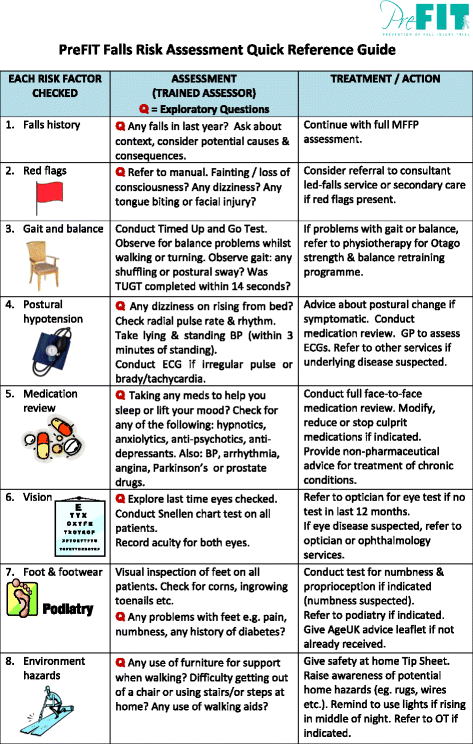10 Easy Facts About Dementia Fall Risk Explained
10 Easy Facts About Dementia Fall Risk Explained
Blog Article
Dementia Fall Risk for Beginners
Table of ContentsThe Only Guide for Dementia Fall RiskThe Basic Principles Of Dementia Fall Risk The Main Principles Of Dementia Fall Risk The 10-Minute Rule for Dementia Fall RiskDementia Fall Risk Things To Know Before You Buy
You could be nervous due to the fact that you've had a loss prior to or since you've noticed you're starting to really feel unstable on your feet. You could have discovered changes to your health and wellness, or just seem like you're slowing down a little. Whatever the factor, it isn't unusual to become cautious and lose confidence, and this can quit you doing the important things you used to do and make you really feel more isolated.If you have actually had an autumn or you have actually begun to feel unstable, tell your doctor even if you really feel great otherwise. Your medical professional can check your balance and the way you stroll to see if improvements can be made. They may be able to refer you for a drops threat assessment or to the drops prevention service.
This info can be obtained via interviews with the person, their caretakers, and an evaluation of their clinical records. Begin by asking the individual concerning their background of falls, consisting of the regularity and situations of any recent drops. Dementia Fall Risk. Inquire regarding any kind of wheelchair problems they may experience, such as unstable or problem strolling
Conduct an extensive evaluation of the person's drugs, paying specific focus to those known to raise the threat of falls, such as sedatives or medicines that lower high blood pressure. Figure out if they are taking multiple drugs or if there have been current changes in their drug program. Examine the person's home environment for possible hazards that can raise the risk of falls, such as poor illumination, loosened rugs, or lack of grab bars in the restroom.
All about Dementia Fall Risk
Overview the individual via the fall threat evaluation type, explaining each question and recording their feedbacks precisely. Calculate the complete risk rating based on the reactions given in the analysis type.
This strategy might consist of exercise programs to improve toughness and balance, medication modifications, home alterations, and recommendations to various other professionals as needed. Consistently check the person's progress and reassess their danger of drops as required. Change the treatment plan based upon changes in their health condition or home atmosphere. Offer recurring education and learning and assistance to advertise safety and reduce the risk of drops in their day-to-day living activities.
Lots of research studies have revealed that physical treatment can assist to decrease the risk of falling in grownups ages 65 and older. In a new research (that looked at falls threat in ladies ages 80 and older), researchers calculated the economic impact of selecting physical therapy to avoid drops, and they located that doing so saves $2,144, consisting of all the concealed prices of your time, check this discomfort, missed life occasions, and the dollars paid for solutions.
3 Easy Facts About Dementia Fall Risk Shown
Analyzing your balance, toughness, and strolling ability. A home safety assessment. Based on the examination results, your physical therapist will design a plan that is tailored to your specific demands.
Older adults that have difficulty strolling and chatting at the exact same time go to a greater risk of dropping. Dementia Fall Risk. To aid boost your safety and security during everyday tasks, your physiotherapist might make a training program that will test you to keep standing and strolling while you do another task. Examples consist of strolling or standing while counting backward, having a discussion, or carrying a bag of click for source groceries
Set objectives for raising their physical task. Exercise much more to increase their toughness and balance. These programs typically are led by volunteer coaches.
Get This Report on Dementia Fall Risk

Measles, or rubeola, is an extremely contagious, severe viral contagious illness brought on by the measles infection. Some individuals think about measles as just a rash and fever that clears in a couple of days; nonetheless, measles can create major health and wellness complications, particularly in kids more youthful than 5-years-old. The best security versus measles is the measles, mumps, and rubella (MMR) vaccination.
Falls are a common reason of injury among older grownups.
Rumored Buzz on Dementia Fall Risk

She has a clinical history of seizure problem and hypertension. She is receiving an IV infusion and taking Gabapentin and Lasix. She has no background of drops, her gait is constant, and she invalidates with no concerns. The previous registered nurse states that she requires support to the washroom when she requires to go.
Instances of usual loss interventions/measures include: Ensuring a patient's important things are within reach. Beyond comprehending just how to use the Johns Hopkins Autumn Danger Analysis Tool, it's crucial that centers incorporate its use into a much more extensive fall avoidance strategy.
Report this page